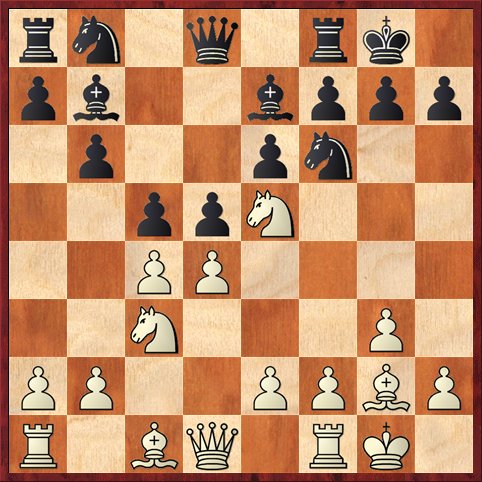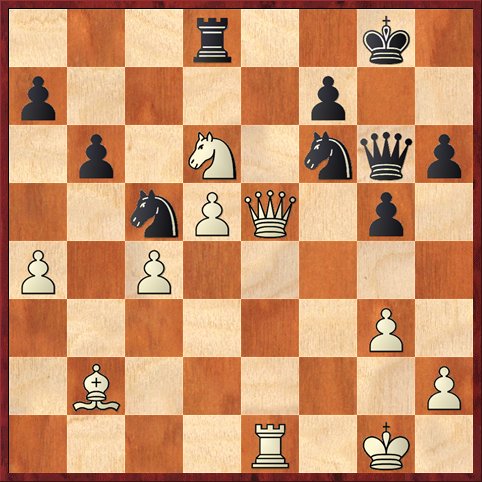Today I had the chance to do something I almost never do, except at tournaments — spend the whole day thinking about chess. That’s one of the nice benefits of the holiday season, when there are no deadlines pressing on me.
Mostly I was getting my thoughts together for my next ChessLecture. There was one position in my most recent lecture that I really didn’t do a good job of analyzing. The lecture was called “Learn From Your Fellow Amateurs, Episode XX: Consolidation,” and I went over Thadeus Frei’s game against Nelson Sowell from the Northern California state championship, where Thadeus went 6-0 in the class B section. (See this post.)
The game began like this:
Thadeus Frei — Nelson Sowell
Queen’s Indian Defense (by transposition)
1. c4 Nf6 2. Nc3 b6 3. Nf3 Bb7 4. g3 e6 5. Bg2 Be7 6. O-O O-O 7. d4 d5 8. Ne5 c5?!
In my lecture I incorrectly stated that this was a pretty good move for Black, but actually it should have gotten him into hot water.
My comments here were a real cop-out. I said that I had never had very much luck playing against this kind of formation as White, and it’s one reason I don’t play queen-pawn openings.
Be that as it may, many of my listeners do play queen-pawn openings, and I owed them a better effort to figure out what was going on.
By “this kind of formation,” I mean a pawn formation where White’s pawns on c4 and d4 butt head to head against Black’s pawns on c5 and d5. As far as I know, this type of pawn formation doesn’t have a name (does anyone know of one?) so I will just call it a “box formation” or “four pawns in a box.” (You can also have box formations elsewhere on the board, but the c- and d-files are the most common locations.)
I have never seen box formations discussed in a textbook. How do you tell whether a box formation is good or bad for you? What should you do when faced with it? The more I thought about it, the more I realized that I had some definite ideas on the subject and that this was worth a ChessLecture. Moreover, I think that this particular position illustrates the themes very well.
I know you’re dying to hear what the answers are, but you’ll have to wait for my lecture!
While I was looking for examples, I came across a couple of games with pretty finishes. For a nice, easy, end-of-year quiz, see if you can figure out White’s winning moves:
White to move.
This is from the game William Kelleher — Larry Kaufman, U.S. Chess League 2006. Black has just played … Be4, attacking the rook on f3. Does White have to move it?
This position is from a game between Fernando Peralta and Alberto Andres Gonzalez, two people whom I know nothing about, from San Sebastian 2005. (Of course, with the Internet there is no excuse for such ignorance. Fernando Peralta is a grandmaster and former champion of Argentina. Andres Gonzalez is a Spanish IM.) White has a lot of pressure on the a1-h8 diagonal, but Black’s knight on f6 is in the way. How can White break through? (Hint: Not with the obvious 1. Qxf6.)
Answers
1. After 1. Rxg7+! Kxg7 2. Rg3+ it’s mate in a couple more moves.
2. Peralta came up with the nice move 1. Ne8! I always think it’s cool when a knight goes all the way to the back rank and strikes the opponent from behind. The first point is that 1. … Nxe8? runs into an immediate mate by 2. Qh8++. The more subtle point is that there is a companion mate after 1. … Rxe8 2. Qxe8+ Nxe8 3. Rxe8+ Kh7 4. Rh8++. Andres Gonzales played 2. … Kg7 instead, but after 3. Bxf6+ he threw in the towel because he is going to have a completely hopeless exchange-down endgame.
By the way, the trouble with 1. Qxf6, a move many chess players might have chosen, is that after 1. … Qxf6 2. Bxf6 Rxd6 3. Re8+ Kh7 4. Rh8+ Kg6 (note how this flight square is now available to Black because the queen is gone), Black is still alive and kicking
Moral: In a position where your opponent’s defenses are stretched to the limit, look for that little extra twist that will push them beyond the limit — often a sacrifice.






{ 2 comments… read them below or add one }
“Box formation” seems like the kind of thing that would have been covered in _Pawn Power_, but I gave away my copy, so can’t be sure.
Although I don’t exactly know the name of the box formation, I know they often produce hanging pawns.